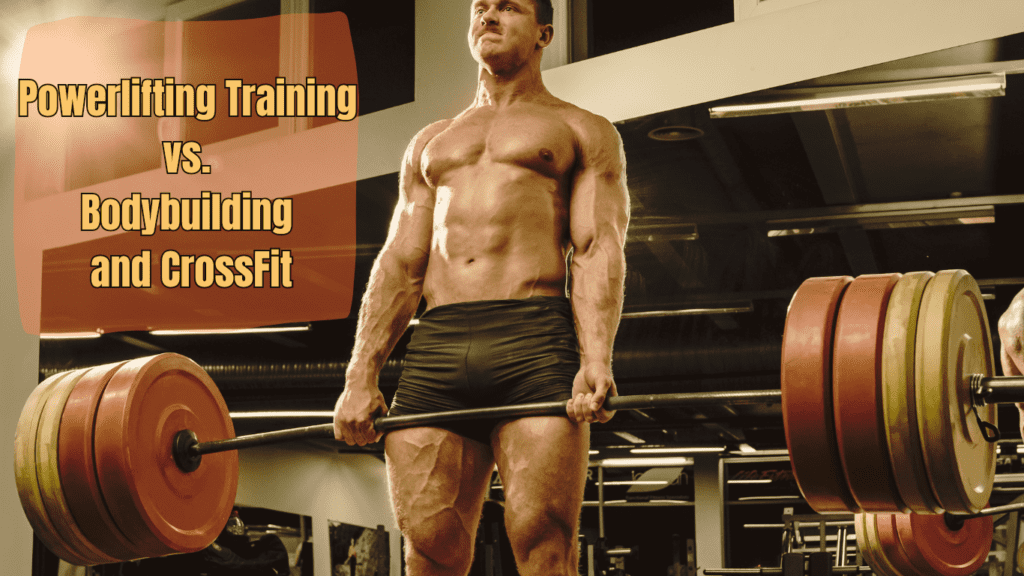Mastering Your Body: An Introduction to Advanced Calisthenics Workout
In this article, we’ll dive into the advanced calisthenics workout, showcasing how this high-intensity, bodyweight training can transform your strength, skill, and overall fitness.
When it comes to fitness, calisthenics stands out as a versatile and effective form of exercise that requires no equipment and can be done anywhere. For those who have mastered the basics, it’s only natural to seek out more challenging routines. This is where an advanced calisthenics workout comes into play. Moving beyond the basics not only keeps your workouts engaging but also brings about significant improvements in strength, flexibility, and endurance. If you’re ready to take your fitness to the next level, this guide is tailored just for you.

Advanced calisthenics involves more complex movements that challenge multiple muscle groups simultaneously. It’s about progressing from simple exercises like push-ups and squats to more demanding variations such as one-arm push-ups, muscle-ups, and pistol squats. These exercises not only require strength but also balance, coordination, and body control, making them a comprehensive approach to fitness. In this article, we’ll delve into some of the key exercises that make up an advanced calisthenics workout, offer tips on how to progress, and provide insights into the science behind these exercises.
The purpose of this guide is to serve as a practical resource for anyone interested in advancing their calisthenics practice. Whether you’re looking to build more muscle, improve your athletic performance, or simply challenge yourself in new ways, this article will provide you with the knowledge and tools you need. Along the way, we’ll break down each exercise, explain the muscles involved, and offer tips on how to perform them correctly to maximize benefits and minimize the risk of injury.
At its core, calisthenics is about mastering control over your body. This control is what allows you to perform movements that, to the untrained eye, may seem impossible. As you progress into an advanced calisthenics workout, you’ll find that many of the exercises involve moving your body through space in ways that require not only strength but also a high degree of coordination. For instance, exercises like the planche and front lever require you to hold your body parallel to the ground, demanding incredible core strength and upper body stability. These are movements that don’t just happen overnight; they require consistent practice and gradual progression.
Subscribe And Get Our Free E-Book:Unlocking The Power Of Nutrition-Supplements, Substitutes, and Superfoods!
One of the key elements of progressing in calisthenics is understanding the concept of progressive overload. This principle is often discussed in weightlifting but is equally important in bodyweight training. Progressive overload involves gradually increasing the difficulty of your workouts to continue making gains in strength and endurance. In the context of an advanced calisthenics workout, this might mean moving from a standard pull-up to a muscle-up, or from a two-legged squat to a pistol squat. Each step up in difficulty should be approached with patience and focus, ensuring that your form remains correct to avoid injury.
Another important aspect of advanced calisthenics is the development of joint strength and mobility. Unlike basic calisthenics, where you might be able to get away with less-than-perfect form, advanced movements often place a significant strain on the joints, particularly in the shoulders, wrists, and knees. This is why it’s crucial to incorporate mobility exercises and joint strengthening into your routine. For example, wrist conditioning exercises can help prepare you for movements like the handstand, where the wrists bear the full weight of the body.
In addition to strength and mobility, muscle endurance plays a significant role in advanced calisthenics. Many of the exercises you’ll be performing require sustained muscle contraction over a period of time. Take the L-sit, for example; holding this position requires your hip flexors, abs, and triceps to work in unison for as long as possible. Building this type of endurance takes time and should be a gradual process, starting with shorter holds and working up to longer durations.
A key tip for anyone embarking on an advanced calisthenics journey is to listen to your body. Pushing too hard, too fast can lead to burnout or injury, which could set back your progress significantly. It’s important to recognize the difference between discomfort that comes from muscle fatigue and pain that signals potential injury. If you’re experiencing the latter, it’s best to take a step back and allow your body the time it needs to recover.
It’s also worth mentioning the role of nutrition in supporting an advanced calisthenics routine. As your workouts become more intense, your body will require more fuel to recover and grow stronger. This means paying attention to your protein intake, as well as ensuring you’re getting enough vitamins and minerals to support joint and muscle health. While calisthenics itself can build a strong, lean physique, your diet plays a crucial role in how well you perform and recover from these demanding workouts.
In summary, advancing in calisthenics is about more than just brute strength. It’s about mastering your body in new and challenging ways. By understanding the principles of progressive overload, prioritizing joint strength and mobility, and listening to your body, you can safely and effectively progress in your calisthenics journey. Whether you’re aiming to perfect a one-arm push-up, hold a planche, or execute a muscle-up, an advanced calisthenics workout provides the roadmap to achieve your goals. The path may be challenging, but the rewards – in terms of strength, body control, and overall fitness – are well worth the effort.
Advanced Calisthenics Workout Video
Understanding Advanced Calisthenics Workout: Progression, Suitability, and Key Concepts
When comparing an advanced calisthenics workout to traditional weightlifting or other forms of exercise, one key difference stands out: calisthenics is centered on mastering control over your own body weight rather than relying on external resistance like dumbbells or machines. This means that as you progress in calisthenics, the exercises themselves become increasingly complex and challenging, requiring a combination of strength, flexibility, and balance that is unique to this form of training.
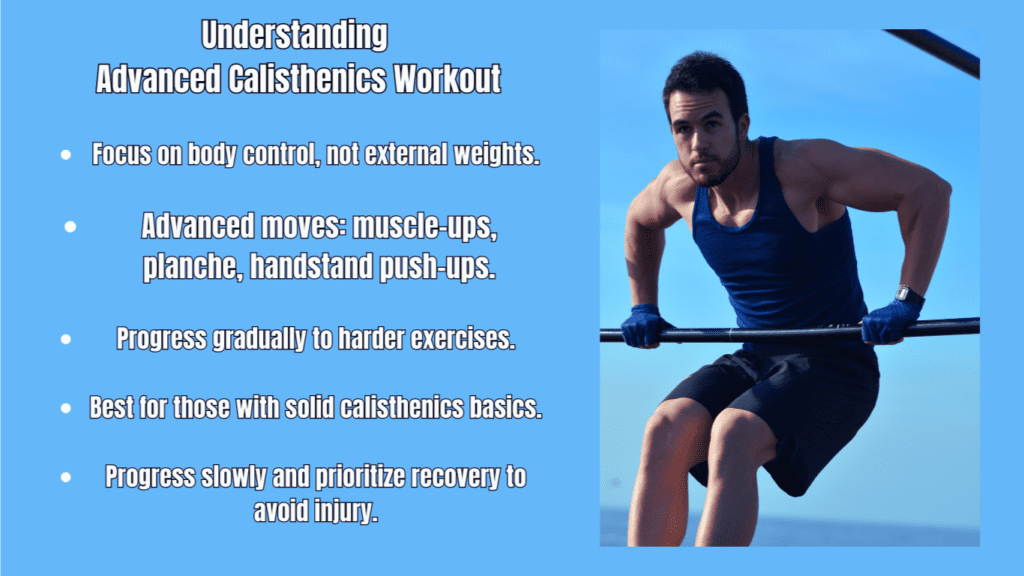
So, what is advanced calisthenics? To put it simply, it’s the practice of performing highly challenging bodyweight exercises that go beyond the basics. While beginner and intermediate calisthenics might focus on movements like push-ups, pull-ups, and dips, advanced calisthenics introduces more complex variations that demand greater control, coordination, and strength. Examples include one-arm push-ups, muscle-ups, handstand push-ups, and planche holds. These exercises not only build muscle and strength but also enhance your body’s overall functional ability, improving balance, coordination, and flexibility. Unlike basic exercises, which might isolate specific muscle groups, advanced calisthenics movements often engage multiple muscles simultaneously, requiring them to work together in harmony.
Who is best suited for an advanced calisthenics workout? This level of training is generally recommended for those who already have a solid foundation in calisthenics or other forms of bodyweight training. It’s crucial that you have a good understanding of your body’s mechanics and a decent level of strength and endurance before attempting advanced exercises. For example, if you can perform multiple sets of standard pull-ups, dips, and push-ups with ease, you may be ready to start exploring more advanced movements. Additionally, those with a background in gymnastics or martial arts may find advanced calisthenics a natural progression due to the similar demands on strength and body control. However, it’s important to note that advanced calisthenics is not just for elite athletes. With the right progression and dedication, anyone can work towards mastering these exercises, regardless of their starting point.
Progression is a critical concept in any advanced calisthenics workout. Unlike traditional weightlifting, where you might increase the resistance by adding more weight to the bar, progression in calisthenics involves making the exercises themselves more challenging. This could mean moving from a standard push-up to a one-arm push-up, or from a basic pull-up to a muscle-up. The key is to ensure that each step up in difficulty is gradual and manageable, allowing your muscles and joints time to adapt to the increased demands. For example, before attempting a full planche, you might start with tuck planche holds, gradually extending your legs as you build strength and confidence. This approach helps to minimize the risk of injury and ensures that your progress is sustainable in the long term.
Understanding the importance of progression is essential for avoiding plateaus and injuries in an advanced calisthenics workout. Plateaus can occur when your body becomes too accustomed to a particular exercise or routine, leading to a slowdown in progress. To keep progressing, you need to continuously challenge your body with new movements or more difficult variations of existing ones. This could involve increasing the duration of holds, decreasing the leverage to make exercises more difficult, or incorporating more dynamic movements. For example, if you’ve mastered the front lever, you could start working on front lever pull-ups, which add a dynamic element to the static hold, further challenging your muscles and coordination.
Another crucial aspect of progression is listening to your body. Advanced calisthenics exercises can place significant strain on your muscles and joints, particularly in areas like the shoulders, wrists, and elbows. It’s important to pay attention to any signs of discomfort or pain and to adjust your training accordingly. If you’re feeling fatigued or noticing any discomfort, it may be a sign that you’re progressing too quickly or not allowing enough time for recovery. Rest and recovery are just as important as the workouts themselves, as they give your muscles time to repair and grow stronger.
In conclusion, advanced calisthenics represents a highly specialized and challenging form of bodyweight training that demands strength, control, and a deep understanding of body mechanics. It differs from basic or intermediate calisthenics in the complexity and difficulty of the exercises, which often require months or even years of dedicated practice to master. While advanced calisthenics is not for beginners, those with a solid foundation in calisthenics or related disciplines can benefit greatly from incorporating these exercises into their routine. The key to success lies in progression—gradually increasing the difficulty of your workouts to continue making gains while minimizing the risk of injury. Whether your goal is to build strength, improve your athletic performance, or simply push your body to new limits, an advanced calisthenics workout offers a challenging and rewarding path to achieving those goals.
Warm-Up and Mobility Drills
An often overlooked but crucial aspect of any advanced calisthenics workout is the warm-up. Did you know that skipping a proper warm-up can reduce your performance by up to 20% and significantly increase your risk of injury? For those engaging in advanced movements, this could mean the difference between a successful training session and a strained muscle or joint. Warm-up and mobility drills are not just about getting the blood flowing—they are essential for preparing your body for the intense demands of an advanced calisthenics workout.
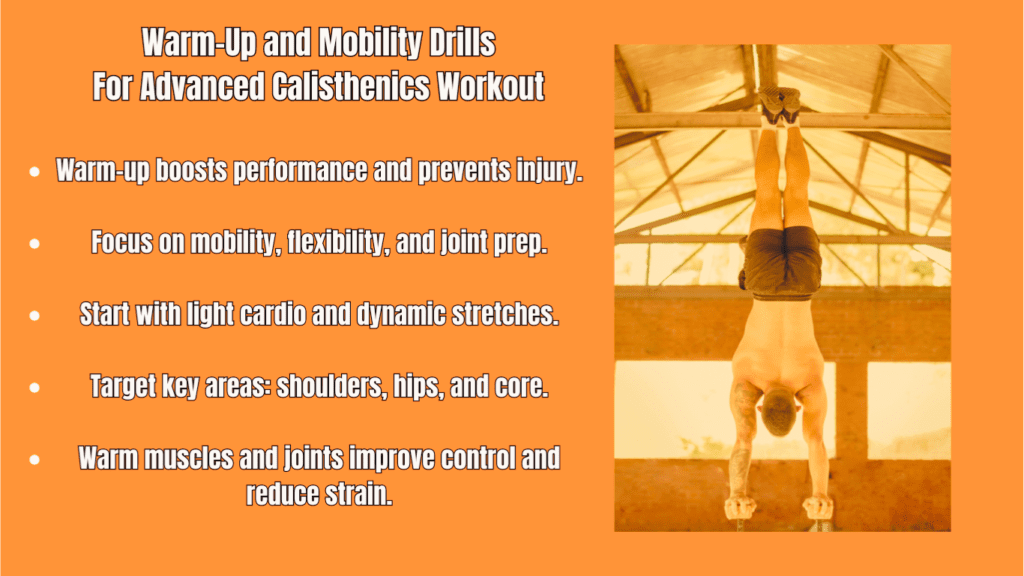
To start, a well-structured warm-up routine should focus on mobility, flexibility, and joint preparation. Unlike basic exercises, where a few arm circles or leg swings might suffice, an advanced calisthenics workout demands a more comprehensive approach to warming up. This is because the exercises you’ll be performing, such as muscle-ups, planche holds, and one-arm push-ups, place significant stress on your muscles, tendons, and joints.
A practical warm-up routine for an advanced calisthenics workout might begin with general movement to increase your heart rate and get your blood pumping. This could include light jogging or jumping jacks for about 5-10 minutes. The goal here is to elevate your core temperature and prepare your cardiovascular system for more intense activity.
Following this, you should incorporate dynamic stretches that target the specific muscle groups you’ll be engaging during your workout. For instance, if your session includes handstand push-ups or planche training, pay special attention to shoulder mobility. Arm circles, shoulder dislocations using a resistance band, and scapular push-ups are excellent choices. These exercises help to increase the range of motion in your shoulders and activate the stabilizing muscles, which are crucial for maintaining balance and control during these advanced movements.
For the lower body, especially if you’re working on movements like pistol squats or L-sits, focus on hip and ankle mobility. Dynamic stretches like hip circles, leg swings, and deep lunges can help loosen up these joints and prepare them for the load-bearing exercises to come. It’s also beneficial to include some core activation exercises, such as hollow body holds or dead bugs, to engage your midsection and ensure it’s ready to support your body during complex movements.
The scientific explanation behind these warm-up exercises is grounded in how the body responds to physical activity. When you begin your warm-up, your blood flow increases, delivering more oxygen and nutrients to your muscles. This process not only enhances muscle function but also reduces the risk of injuries by ensuring your muscles are more pliable and ready to stretch under load. Warm muscles are less prone to tears and strains, which is particularly important when performing high-intensity, complex movements in an advanced calisthenics workout.
Additionally, warming up prepares your nervous system for the demands of your workout. Many advanced calisthenics exercises require a high degree of neuromuscular coordination—your brain needs to efficiently communicate with your muscles to execute precise movements. A good warm-up can enhance this communication, improving your reaction time and control, which are crucial for maintaining proper form and technique.
Another key component of a warm-up is the role of synovial fluid in joint health. Synovial fluid is the lubricant that cushions your joints, reducing friction and wear during movement. When you warm up, the production of synovial fluid increases, which helps to protect your joints, particularly during exercises that involve a lot of joint stress, such as planche holds or muscle-ups. This increased fluid not only makes movements smoother but also ensures that your joints can handle the intensity of an advanced calisthenics workout without the risk of injury.
Incorporating a thorough warm-up into your advanced calisthenics workout is not just recommended—it’s essential. By focusing on mobility, flexibility, and joint preparation, you’re setting yourself up for a successful and safe workout. Not only does warming up enhance performance, but it also plays a critical role in injury prevention. So, next time you’re tempted to skip the warm-up, remember that it’s an investment in your body’s long-term health and performance.
And here’s a little joke to finish off: Why did the muscle refuse to go to the gym without warming up first? Because it didn’t want to be in a heated argument with the joints!
Chart: Strength, Mobility, and Endurance in Advanced Calisthenics

Explanation of the Chart
The “Triad of Mastery” chart provides a comprehensive overview of the essential requirements for mastering advanced calisthenics exercises. It categorizes the demands of various movements into three critical components: strength, mobility, and endurance.
- Strength Requirements: This section indicates the level of strength necessary to perform each exercise effectively. Movements like the planche hold and front lever require the highest strength levels due to the significant engagement of multiple muscle groups. Building strength is fundamental to progressing in calisthenics, as these complex movements challenge your body’s ability to lift and control its weight.
- Mobility Requirements: Mobility is crucial for executing advanced calisthenics movements with proper form and technique. Exercises such as the pistol squat and planche hold demand exceptional flexibility and joint mobility to ensure that you can perform these movements safely and effectively. Incorporating mobility drills into your warm-up routine is vital to preparing your body for the intense demands of these advanced exercises.
- Endurance Requirements: Endurance plays a significant role in maintaining performance during prolonged or repetitive movements. The chart illustrates that exercises like the L-sit and planche hold require substantial muscular endurance to sustain positions for longer durations. Building endurance through gradual progression is essential, as it allows your muscles to perform at a high level over extended periods without fatigue.
By understanding the interrelated nature of these three components, practitioners can tailor their training programs to ensure balanced development in strength, mobility, and endurance. This chart serves as a valuable resource for anyone looking to assess their readiness for advanced calisthenics, providing a clear pathway to mastering challenging bodyweight exercises while minimizing the risk of injury.
Core Advanced Calisthenics Exercises
When it comes to an advanced calisthenics workout, the complexity and intensity of the exercises are significantly higher than those found in traditional strength training. Did you know that mastering a muscle-up or a planche can activate up to 70% of your body’s muscles simultaneously? This kind of full-body engagement is what makes advanced calisthenics so unique and effective. In this section, we’ll break down some of the core exercises that define an advanced calisthenics workout, explaining how to perform them, the science behind them, and tips for maximizing your results.
Muscle-Ups
Starting with the muscle-up, this is one of the most iconic moves in calisthenics. It combines a pull-up with a dip in one fluid motion, taking you from hanging below the bar to having your chest above it. To perform a muscle-up, start with a false grip, where your wrists are above the bar instead of just your palms. This grip allows for a smoother transition from the pull-up phase to the dip phase. Begin by performing an explosive pull-up, aiming to get your chest as close to the bar as possible. As you reach the top of the pull-up, transition by rotating your wrists and pushing your chest forward over the bar, then press down to complete the dip.
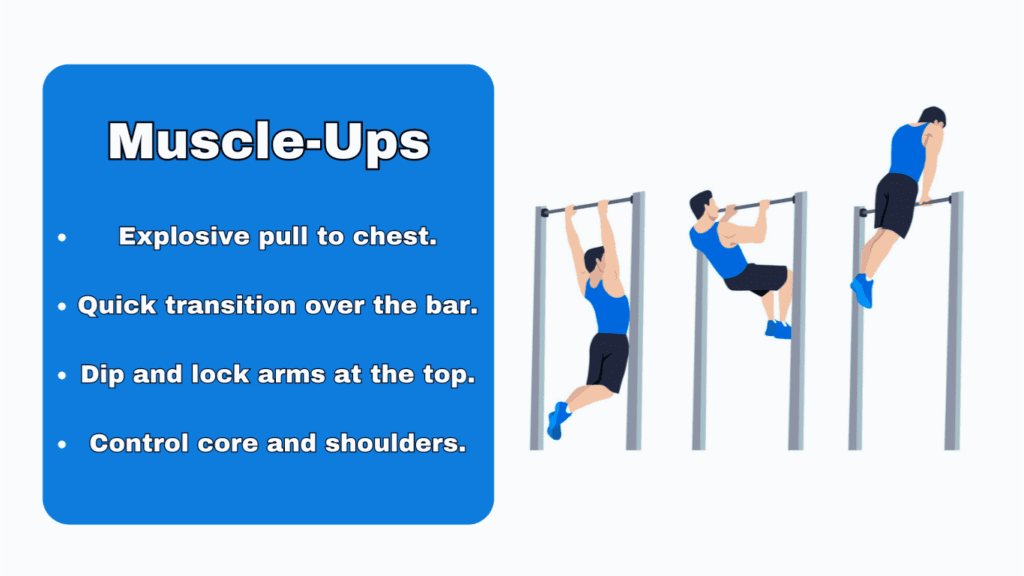
The muscle-up primarily engages the latissimus dorsi (lats), biceps, triceps, and core muscles. The pull-up phase heavily involves the lats and biceps, while the dip phase activates the triceps and shoulders. What makes the muscle-up particularly challenging is the need for coordination and timing between these muscle groups. Explosive power is key to getting your chest above the bar, which is why many people start with assisted muscle-ups using resistance bands or focus on negative muscle-ups (slowly lowering yourself from the top position) to build strength.
To improve your muscle-ups, focus on developing explosive strength in your pull-ups and dips. Practice with band assistance or partner assistance to gradually increase your power. Additionally, incorporate core exercises like hollow body holds to enhance your ability to maintain a tight, efficient body line throughout the movement.
Handstand Push-Ups
Next, we have the handstand push-up, another fundamental exercise in an advanced calisthenics workout. This movement involves pressing your body weight from an inverted position, either against a wall or freestanding. Start by kicking up into a handstand against a wall. Your hands should be shoulder-width apart, with fingers spread wide for better balance. Lower yourself slowly until your head touches the ground, then press back up, keeping your body as straight as possible. As you progress, you can work on freestanding handstand push-ups, which require not only strength but also significant balance and body control.
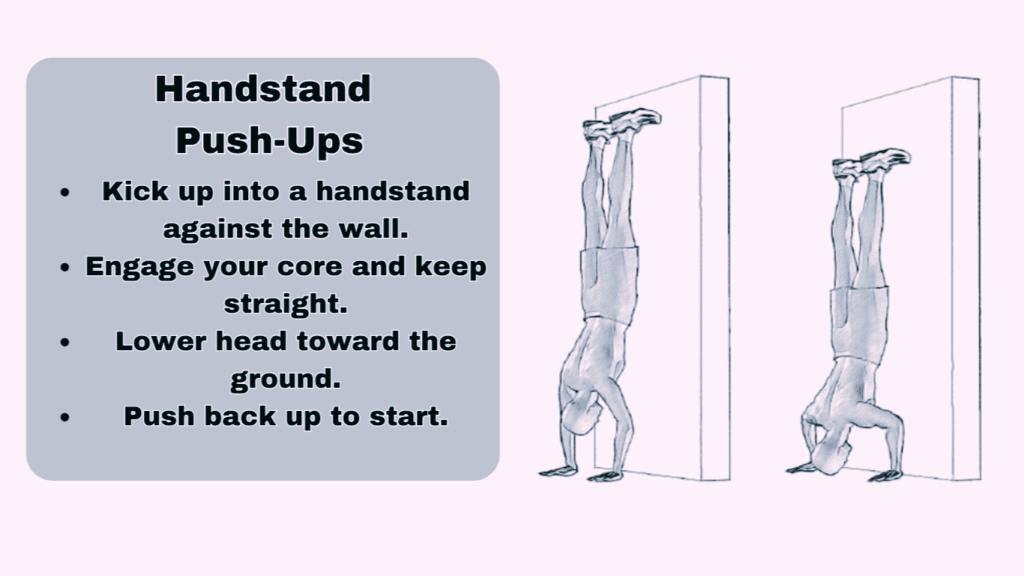
From a biomechanical perspective, handstand push-ups are essentially inverted presses that heavily engage the deltoids (shoulder muscles), triceps, and upper chest. The core plays a critical role in stabilizing your body throughout the movement, preventing any arching or bending at the waist. Shoulder stability is crucial, as the shoulders bear the brunt of your body weight during the press. This makes shoulder mobility and strength essential components of training for handstand push-ups.
To achieve better results in handstand push-ups, prioritize shoulder mobility and strength. Start with wall-supported handstands, gradually progressing to partial range of motion push-ups, and eventually full push-ups. Incorporating exercises like pike push-ups and wall walks can help build the necessary strength and confidence for freestanding variations.
Front Lever
Moving on to the front lever, this is an advanced calisthenics move that involves holding your body horizontally while hanging from a bar. The key to achieving a front lever is mastering body alignment and core engagement. Begin by hanging from a bar with a shoulder-width grip, then engage your core and lats to lift your body into a horizontal position. Your body should form a straight line from head to heels, parallel to the ground.
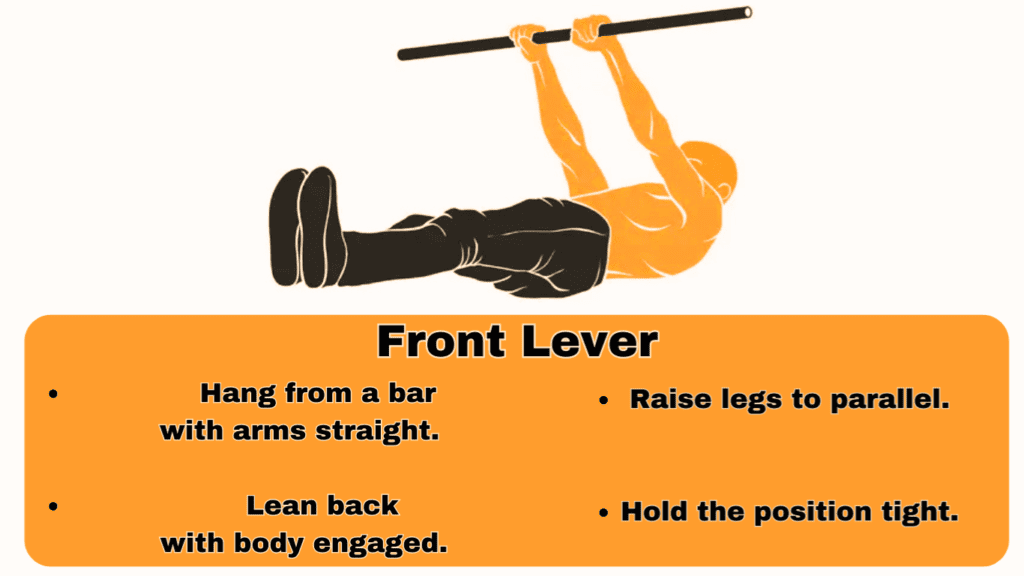
The front lever is a demanding exercise that requires significant strength in the lats, core, and lower back. Holding your body in a horizontal position defies gravity, placing a tremendous load on these muscle groups. The physics behind this movement involves maintaining a lever, with your body acting as the lever arm and your lats and core providing the necessary torque to hold the position.
To progress toward a front lever, start with tuck lever holds, where you keep your knees close to your chest. As you build strength, extend one leg at a time, working towards a one-leg lever before attempting the full front lever. Consistent practice of exercises like hanging leg raises and dragon flags will also help strengthen the core and lats for this challenging move.
Planche
The planche is another pinnacle move in an advanced calisthenics workout. It involves holding your body parallel to the ground, supported only by your hands, with your legs extended behind you. Achieving a planche requires a combination of upper body strength, particularly in the shoulders and chest, as well as incredible core and wrist strength. To start, practice the tuck planche, where your knees are tucked close to your chest. Gradually work towards extending your legs as your strength improves.

In terms of load distribution, the planche places significant stress on the shoulders, wrists, and core. The shoulders must be strong enough to support your entire body weight, while the wrists need to be flexible and stable to maintain balance. The core plays a critical role in keeping your body straight and rigid, preventing your hips from sagging.
To improve in the planche, focus on wrist flexibility and strength. Exercises like wrist push-ups and planche leans can help build the necessary endurance in the wrists and shoulders. Maintaining body tension throughout the movement is crucial, so regularly practice static holds and progressions, such as the straddle planche or advanced tuck planche, to build up to the full position.
Other Advanced Calisthenics Exercises
In addition to these key exercises, an advanced calisthenics workout might also include movements like the human flag and back lever. The human flag involves holding your body horizontally while gripping a vertical pole, requiring immense strength in the obliques and lats. The back lever, on the other hand, is a challenging move where you hold your body in a horizontal position facing downwards, engaging the shoulders, lats, and core.
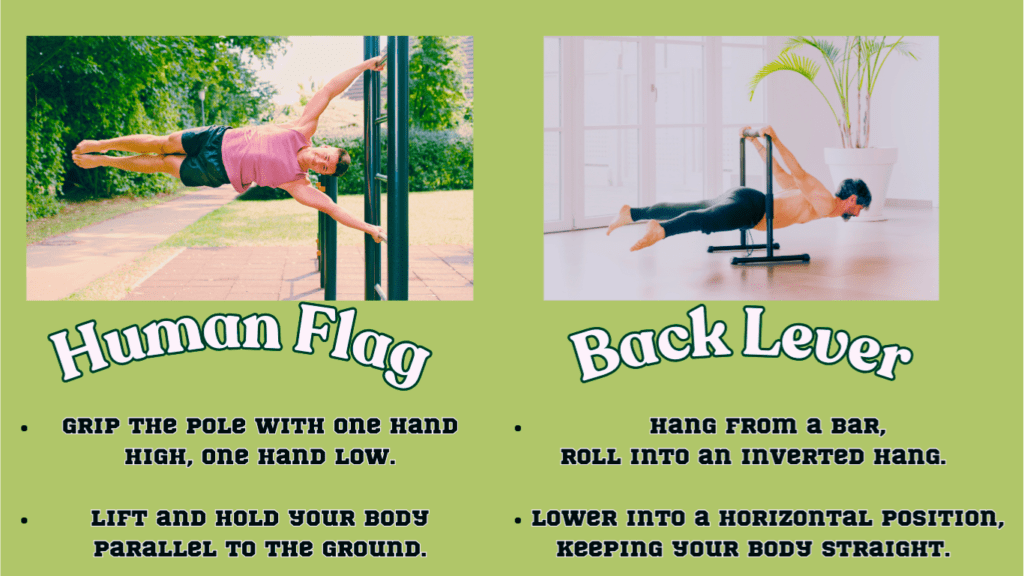
Each of these exercises requires dedication, consistent practice, and a methodical approach to progression. Mastering them not only enhances your strength and coordination but also provides a sense of accomplishment that few other workouts can match.
And to wrap it up with a light-hearted note: Why don’t advanced calisthenics athletes ever get lost? Because they always know how to stay “on the bar” and never lose their grip on directions!
Supplemental Exercises for Strength and Endurance
When undertaking an advanced calisthenics workout, incorporating supplemental exercises can significantly enhance both strength and endurance. Did you know that the pistol squat and one-arm pull-up are not only impressive feats of strength but also demonstrate the level of control and muscle coordination required for advanced calisthenics? These exercises are critical for pushing the boundaries of what you can achieve with bodyweight training. Let’s explore these supplemental exercises in detail, focusing on how to perform them, the science behind them, and tips for improvement.
Pistol Squats
The pistol squat is a single-leg squat that requires not just strength but also balance and flexibility. To perform a pistol squat, start by standing on one leg with the other leg extended in front of you. Lower yourself slowly by bending the standing leg while keeping the extended leg off the ground. Aim to go as low as possible while maintaining balance. Push through the heel of the standing leg to return to the starting position.
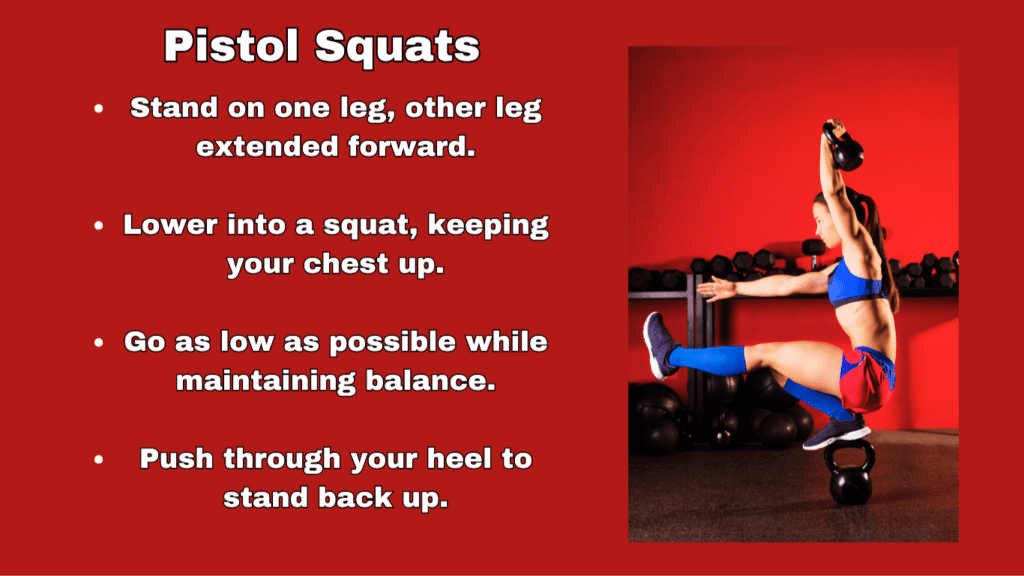
Pistol squats challenge your body’s balance and strength, specifically targeting the quadriceps, hamstrings, glutes, and stabilizer muscles. The biomechanics of a single-leg squat involve a high degree of ankle mobility and hip flexibility, as well as the ability to stabilize the knee and hip joints under load. This makes the pistol squat an excellent exercise for improving overall lower body strength and coordination.
For progression, start with assisted pistol squats, using a chair or a wall for support. Gradually decrease the assistance as your strength and balance improve. Incorporate exercises like Bulgarian split squats and step-ups to build the necessary strength and stability for unassisted pistol squats.
One-Arm Pull-Ups
Moving on to the one-arm pull-up, this exercise is a significant milestone in upper-body strength training. To begin working towards a one-arm pull-up, start with regular pull-ups and gradually move to assisted one-arm pull-ups using a band or a partner for support. Grip variations, such as using a towel or neutral grip, can also help in building the necessary strength.
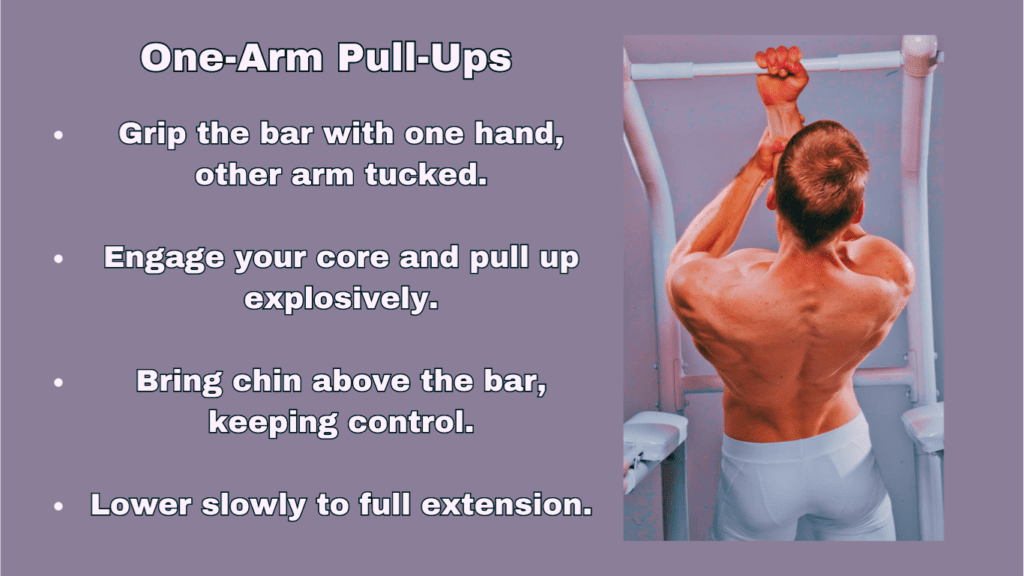
In a one-arm pull-up, the demands on the biceps, lats, and core are immense. The exercise requires not only the strength to pull your body weight with one arm but also significant core activation to maintain stability and control. It is often considered a benchmark of upper-body strength and control due to the extreme load placed on the pulling arm and the core muscles.
To progress to a one-arm pull-up, practice with one-arm negative pull-ups, where you focus on slowly lowering yourself from the top position. Strengthen your biceps and lats with supplementary exercises like chin-ups, rows, and bicep curls. Consistent practice and gradual progression are key to achieving a full one-arm pull-up.
Tiger Bend Push-Up
The Tiger Bend Push-Up is an advanced calisthenics movement that showcases exceptional triceps, shoulder, and core strength. To perform the Tiger Bend Push-Up, begin in a forearm plank position and push up onto your hands, transitioning into a handstand push-up position, before lowering yourself back down to your forearms. This movement requires precise control and stability throughout.
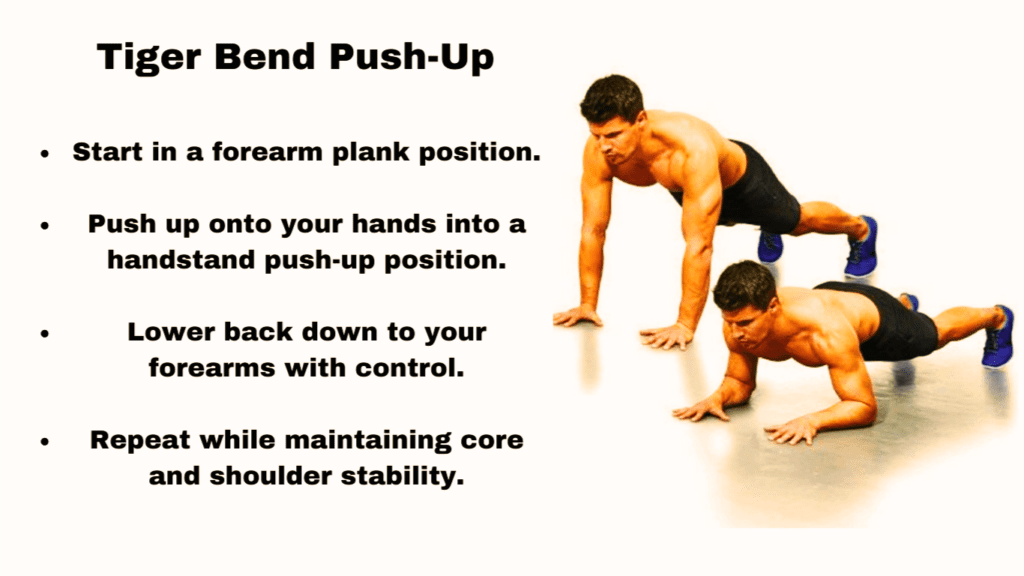
From a scientific perspective, the Tiger Bend Push-Up emphasizes the eccentric and concentric phases of pushing movements, placing intense demands on your triceps and shoulder stabilizers. The exercise also heavily recruits core muscles to maintain balance and proper body alignment as you move through the range of motion.
To progress, start by mastering the forearm plank and basic push-ups. Focus on building strength in your triceps and shoulders with exercises like dips and pike push-ups. As you advance, work on partial reps, gradually increasing the range of motion until you’re able to perform full Tiger Bend Push-Ups with control. Core engagement and shoulder mobility are key to safely performing this challenging exercise.
Additional Advanced Calisthenics Exercises
In addition to these exercises, consider incorporating movements like the back lever and L-sit into your routine. The back lever involves holding your body horizontally while facing downwards, requiring strength in the shoulders, lats, and core. The L-sit, where you hold your body in an L-shape while seated, is excellent for building core and hip flexor strength.
Each of these exercises plays a crucial role in enhancing your overall performance in an advanced calisthenics workout. They not only improve strength and endurance but also help in developing the muscle control and stability necessary for advanced bodyweight movements.
And to end on a humorous note: Why did the calisthenics athlete bring a ladder to the gym? Because they heard the human flag was a real “up-and-coming” exercise!
Chart: Muscle Activation and Performance Metrics for Key Advanced Calisthenics Exercises
| Exercise | Primary Muscle Groups Engaged | Key Performance Metrics | Progression Strategies |
|---|---|---|---|
| Muscle-Up | Lats, Biceps, Triceps, Shoulders, Core | Height of Pull-Up, Smoothness of Transition | Assisted muscle-ups, explosive pull-ups, negative muscle-ups |
| Handstand Push-Up | Deltoids, Triceps, Upper Chest, Core | Reps to Failure, Balance Control | Wall-supported handstands, partial range push-ups, pike push-ups |
| Front Lever | Lats, Core, Lower Back | Hold Time in Horizontal Position | Tuck lever holds, one-leg lever, hanging leg raises |
| Planche | Shoulders, Chest, Core, Wrists | Hold Time, Body Tension | Tuck planche, straddle planche, planche leans |
| Pistol Squat | Quadriceps, Hamstrings, Glutes, Stabilizer Muscles | Depth of Squat, Balance Maintenance | Assisted pistol squats, Bulgarian split squats, step-ups |
| One-Arm Pull-Up | Biceps, Lats, Core | Reps, Negative Pull-Up Time | One-arm negatives, assisted one-arm pull-ups, grip variations (towel or neutral grip) |
| Tiger Bend Push-Up | Triceps, Shoulders, Core | Reps to Failure, Stability | Forearm plank holds, basic push-ups, partial Tiger Bend Push-Ups |
| Human Flag | Obliques, Lats, Shoulders | Hold Time, Body Alignment | Tuck flags, assisted flags, progression to full flags |
| Back Lever | Shoulders, Lats, Core | Hold Time in Horizontal Position | Tuck back lever holds, assisted back levers, progressing to full back lever |
| L-Sit | Core, Hip Flexors, Shoulders | Hold Time, Stability | Tuck sits, supported L-sits, progressing to full L-sits |
Explanation of the Chart
This chart serves as a quick reference guide that complements your detailed descriptions of the advanced calisthenics exercises. Here’s how the chart enhances your article:
- Visual Overview: It provides a clear, at-a-glance overview of the primary muscles targeted in each exercise, helping readers understand the full-body engagement of advanced calisthenics.
- Key Performance Metrics: By including metrics such as reps, hold times, and balance control, readers can track their progress and set specific goals related to each exercise.
- Progression Strategies: Each exercise includes progression strategies, offering readers practical advice on how to improve and advance in their training.
- Engagement: The chart encourages engagement by summarizing complex information in a user-friendly format, making it easier for readers to absorb and apply what they learn.
Cool Down and Stretching
An advanced calisthenics workout is intense and demanding, making the cool-down phase just as important as the workout itself. Did you know that skipping a proper cool-down can lead to increased muscle soreness and hinder your recovery? Taking time to cool down and stretch can significantly enhance your overall performance and reduce the risk of injuries. In this section, we’ll explore a comprehensive cool-down routine and the science behind why it’s essential for any advanced calisthenics workout.
Practical Explanation: Cool-Down Routine
After completing your advanced calisthenics workout, it’s crucial to transition your body from the high-intensity phase to a state of relaxation. Start your cool-down routine with light cardio, such as walking or gentle jogging, for about 5 minutes. This helps to gradually lower your heart rate and promote blood flow to the muscles that were heavily engaged during the workout.
Following the light cardio, move on to static stretching. This type of stretching involves holding each stretch for about 20 to 30 seconds without bouncing or jerking. Focus on major muscle groups that you worked during your calisthenics session. Key stretches include:
- Hamstring Stretch: Sit on the floor with one leg extended and the other bent. Reach towards the toes of the extended leg, keeping your back straight.
- Quad Stretch: Stand on one leg, pulling the opposite heel towards your glutes. Keep your knees close together and push your hips forward slightly.
- Chest Stretch: Stand with your arms extended behind you, interlace your fingers, and gently lift your arms to stretch the chest.
- Shoulder Stretch: Bring one arm across your body and use the opposite arm to gently press it towards your chest.
- Back Stretch: Lie on your back, bring your knees to your chest, and gently rock side to side to stretch the lower back.
These static stretches help in lengthening the muscles and improving overall flexibility. Ensure that you breathe deeply and slowly during each stretch, which aids in muscle relaxation and reduces tension.
Scientific Explanation: Benefits of Cooling Down
Cooling down after an advanced calisthenics workout offers several scientifically supported benefits. One of the primary advantages is the reduction of muscle soreness. After intense exercise, your muscles accumulate metabolic byproducts like lactic acid, which can contribute to soreness. Light cardio helps to flush these byproducts out of the muscles and facilitates quicker recovery.
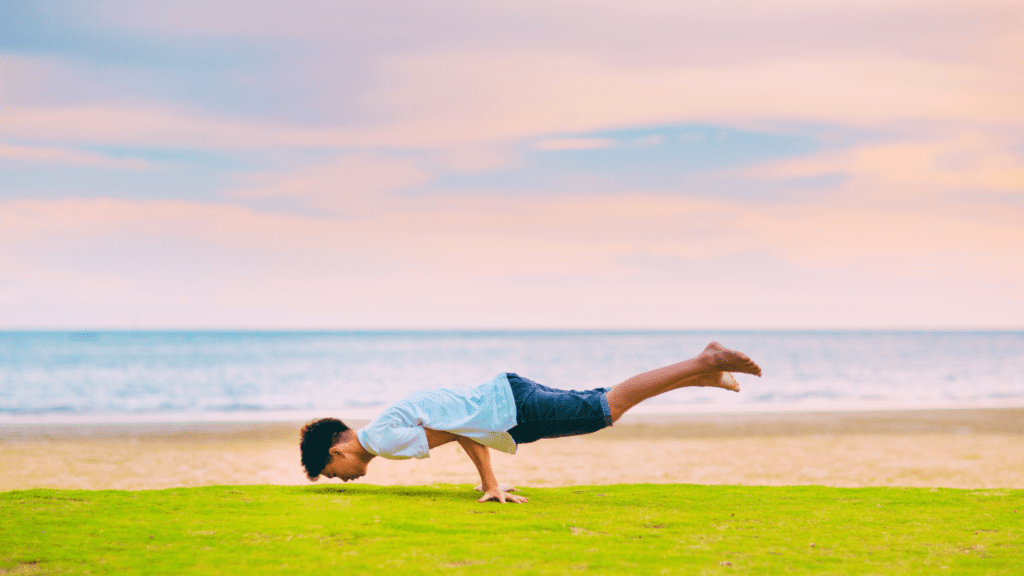
Another benefit of cooling down is aiding recovery. Engaging in a cool-down routine helps in gradually decreasing your heart rate and prevents blood from pooling in your extremities. This ensures that your cardiovascular system returns to its normal state more efficiently and supports the recovery process.
Maintaining flexibility is also a key benefit of cooling down. Static stretching helps to keep your muscles elongated and flexible, reducing the risk of stiffness and improving your range of motion. Regular stretching can contribute to better overall performance in your advanced calisthenics workout, as flexible muscles are less prone to injuries and can perform movements more efficiently.
Additionally, cooling down can help in preventing injuries. By allowing your muscles to return to their normal state gradually, you decrease the risk of strains and sprains. This is especially important in advanced calisthenics, where exercises involve complex and demanding movements that place significant stress on the body.
Incorporating a thorough cool-down and stretching routine into your advanced calisthenics workout is essential for optimal recovery and performance. By following a structured cool-down routine that includes light cardio and static stretching, you can enhance your flexibility, reduce muscle soreness, and support overall recovery.
And here’s a light-hearted joke to finish this part of the article: Why did the advanced calisthenics athlete bring a ladder to the cool-down session? To reach new heights in flexibility!
Common Mistakes and How to Avoid Them
An advanced calisthenics workout presents unique challenges that can make it easy to slip into common mistakes if you’re not careful. Did you know that even slight errors in technique during advanced movements can significantly impact your performance and lead to injuries? Let’s dive into some specific mistakes associated with advanced calisthenics and explore how to correct them effectively.
Common Mistakes and How to Avoid Them
1. Inadequate Progression
In advanced calisthenics, jumping into high-difficulty exercises without proper progression is a frequent error. For instance, attempting a muscle-up or planche without first mastering foundational movements can lead to ineffective practice and increased risk of injury.
Solution: Follow a structured progression plan tailored for each advanced exercise. For example, before attempting a muscle-up, ensure you can perform multiple strict pull-ups and dips. For a planche, start with tuck planche holds and gradually progress to extended holds as your strength and balance improve. Use intermediate variations like assisted muscle-ups and tuck planches to build the necessary strength and skill.
2. Poor Technique and Form
Advanced exercises like the human flag or one-arm pull-ups require precise technique. Mistakes such as improper grip, body alignment, or incorrect movement patterns can compromise the effectiveness of the exercise and increase the risk of injury. For instance, during a handstand push-up, improper shoulder alignment can lead to shoulder strain or injury.
Solution: Prioritize mastering the form of each exercise. Utilize video feedback or work with a coach to ensure correct technique. For exercises like the front lever, focus on maintaining proper body alignment and engaging your core throughout the movement. Practice exercises in front of a mirror or record your workouts to monitor and correct your form.
3. Overtraining and Insufficient Recovery
In advanced calisthenics, the intensity of exercises can lead to overtraining if proper recovery is not observed. Overtraining can result in decreased performance, increased injury risk, and prolonged muscle soreness. For example, performing high-volume muscle-ups or handstand push-ups without adequate rest can hinder recovery and lead to chronic fatigue.
Solution: Implement a balanced training schedule with built-in rest days and active recovery sessions. Avoid training the same muscle groups intensely on consecutive days. Incorporate lighter sessions focused on mobility and flexibility to aid recovery. Monitor signs of overtraining, such as persistent soreness or decreased motivation, and adjust your training intensity accordingly.
4. Neglecting Warm-Up and Cool-Down
Advanced calisthenics exercises place significant stress on the body, making warm-up and cool-down essential. Skipping these steps can lead to increased injury risk and suboptimal performance. For instance, not warming up properly before attempting a back lever or planche can result in muscle strains or joint injuries.
Solution: Dedicate time to a thorough warm-up that includes dynamic stretches and mobility drills specific to the movements you will perform. For instance, before tackling muscle-ups, warm up your shoulders and wrists with dynamic movements and light exercises. After your workout, engage in static stretching to aid muscle recovery and maintain flexibility.
5. Ignoring Individual Limitations
In advanced calisthenics, ignoring individual limitations can lead to injury and frustration. Not every advanced exercise suits every individual, and pushing beyond your limits without adequate preparation can have negative consequences. For instance, if you struggle with shoulder mobility, attempting advanced handstand push-ups without addressing these limitations can lead to injury.
Solution: Recognize and respect your personal limits. Modify exercises to accommodate your current capabilities and gradually work towards more challenging variations. For example, use wall support for handstands or perform assisted versions of advanced exercises until you build the necessary strength and mobility.
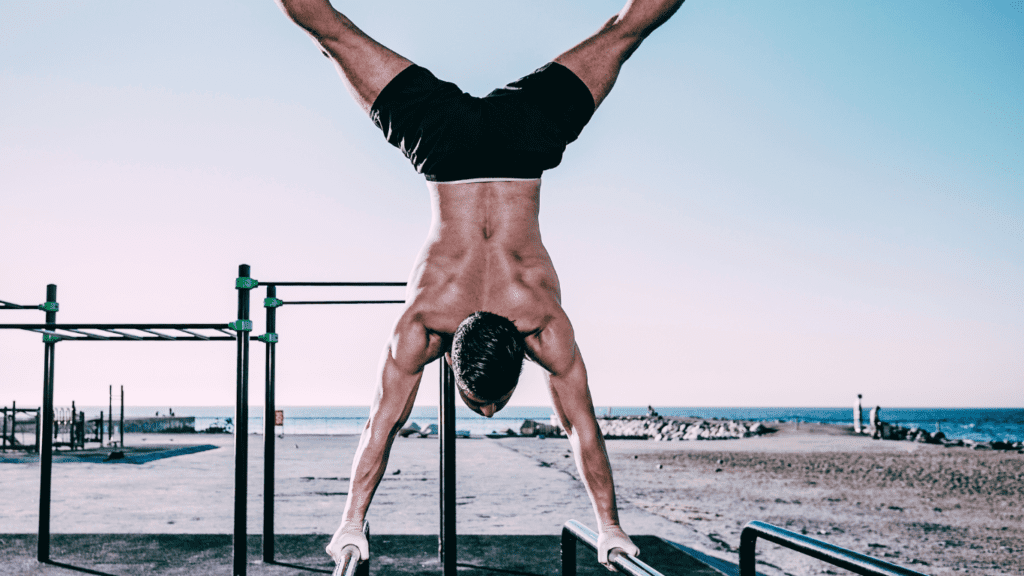
Scientific Explanation: Consequences of Mistakes
Inadequate progression in advanced calisthenics can lead to a lack of skill development and increased injury risk. Without proper progression, your body may not be prepared for the demands of advanced movements, leading to ineffective practice and potential injuries.
Poor technique and form can cause muscle imbalances and joint stress. Incorrect form during complex exercises like the front lever or planche can place undue strain on specific muscle groups or joints, increasing the likelihood of strain or injury.
Overtraining affects recovery and performance. Inadequate recovery time can lead to chronic fatigue, decreased muscle strength, and increased injury risk. It’s essential to balance intense workouts with appropriate rest and recovery strategies.
Neglecting warm-up and cool-down can impair muscle recovery and flexibility. Without proper warm-up, muscles and joints may not be adequately prepared for intense exercise, leading to injuries. Skipping cool-down can result in prolonged muscle soreness and stiffness.
Ignoring individual limitations can result in injury and hinder progress. It’s important to adjust exercises based on your current strength, mobility, and skill level to prevent overexertion and ensure safe progression.
Avoiding these common mistakes is crucial for a safe and effective advanced calisthenics workout. By focusing on proper progression, technique, recovery, warm-up, and respecting individual limitations, you can enhance your performance and reduce the risk of injury.
And here’s a light-hearted joke to wrap things up: Why did the calisthenics athlete avoid the jungle gym? Because they didn’t want to “swing” into any mistakes!
Nutrition and Recovery
When it comes to an advanced calisthenics workout, proper nutrition and recovery are just as crucial as the exercises themselves. Did you know that without adequate nutrition and recovery, your performance in advanced calisthenics can plateau or even decline, no matter how hard you train? Ensuring you support your body with the right nutrients and recovery techniques can make a significant difference in achieving your fitness goals. Let’s dive into the essential aspects of nutrition and recovery specifically for advanced calisthenics.
Practical Explanation: Nutritional Advice
1. Protein
For those engaged in an advanced calisthenics workout, protein is a key component for muscle repair and growth. During intense calisthenics exercises, your muscles undergo significant stress and micro-tears. Consuming an adequate amount of protein helps repair these tears and promotes muscle growth. Aim for approximately 1.2 to 2.0 grams of protein per kilogram of body weight per day, depending on the intensity of your workouts and your individual needs.
Sources: Incorporate lean meats, fish, eggs, dairy products, and plant-based proteins like legumes, tofu, and tempeh into your diet. A protein shake or bar can also be a convenient option for meeting your daily requirements, especially post-workout.
2. Carbohydrates
Carbohydrates are your body’s primary energy source, especially during high-intensity advanced calisthenics exercises. Carbs help replenish glycogen stores that get depleted during workouts, ensuring you have the energy needed for optimal performance and recovery. Focus on complex carbohydrates, which provide sustained energy and essential nutrients.
Sources: Include whole grains, fruits, vegetables, and legumes in your diet. For example, brown rice, quinoa, sweet potatoes, and oats are excellent choices. Eating a balanced meal with carbs before and after your workout can enhance performance and recovery.
3. Hydration
Hydration is often overlooked but is crucial for any advanced calisthenics workout. Adequate fluid intake helps regulate body temperature, maintain electrolyte balance, and support muscle function. Dehydration can lead to decreased performance, muscle cramps, and fatigue.
Recommendation: Drink water throughout the day and especially before, during, and after your workouts. Consider adding electrolyte-rich beverages if you’re sweating heavily or training in hot conditions.
Scientific Explanation: Role of Nutrition in Recovery and Growth in Advanced Calisthenics Workout
Protein plays a vital role in muscle recovery and growth. During intense calisthenics exercises, muscles experience micro-tears. The amino acids from protein help repair these tears, leading to muscle hypertrophy and improved strength. Inadequate protein intake can delay recovery and impede muscle growth, making it essential to consume sufficient amounts daily.
Carbohydrates are crucial for replenishing glycogen stores, which get depleted during prolonged or high-intensity workouts. Glycogen is stored in the muscles and liver and serves as a key energy source during exercise. After a workout, replenishing these stores with carbohydrates helps restore energy levels and promotes faster recovery.
Hydration supports various physiological functions necessary for recovery and performance. Water helps transport nutrients to cells, remove waste products, and regulate body temperature. Proper hydration can prevent muscle cramps and fatigue, improving overall workout efficiency and recovery.
Recovery Techniques: Enhancing Recovery
1. Foam Rolling
Foam rolling, or self-myofascial release, is an effective recovery technique for those engaged in advanced calisthenics. It involves using a foam roller to apply pressure to muscle tissues, which helps release muscle tightness and improve blood flow. This can aid in reducing muscle soreness and enhancing flexibility.
Scientific Benefit: Foam rolling helps increase blood flow to the muscles, which can accelerate the removal of metabolic waste products and delivery of nutrients necessary for muscle repair. It also helps in breaking up adhesions and improving muscle elasticity.
2. Adequate Sleep
Sleep is crucial for muscle recovery and overall health. During sleep, the body releases growth hormones that facilitate tissue repair and muscle growth. For those involved in intense advanced calisthenics, adequate sleep is essential for optimal recovery and performance.
Recommendation: Aim for 7-9 hours of quality sleep per night. Establish a regular sleep schedule and create a restful environment to improve sleep quality.
3. Active Recovery
Active recovery involves engaging in low-intensity exercises on rest days to promote blood circulation and muscle recovery. Activities such as light jogging, yoga, or swimming can help maintain flexibility, reduce muscle soreness, and speed up recovery.
Scientific Benefit: Active recovery helps maintain blood flow to muscles, which aids in nutrient delivery and waste removal. It also helps reduce stiffness and promote relaxation.
Proper nutrition and recovery techniques are integral to a successful advanced calisthenics workout. By focusing on adequate protein, carbohydrates, and hydration, as well as incorporating effective recovery practices like foam rolling, sufficient sleep, and active recovery, you can enhance your performance and support muscle growth.
And to end on a lighter note: Why did the advanced calisthenics athlete bring a water bottle to bed? To ensure they stayed hydrated in their dreams of perfect reps!
How to Create a Tailored Advanced Calisthenics Workout Plan for Maximum Results
When it comes to an advanced calisthenics workout, crafting an effective workout plan is essential for reaching your fitness goals and ensuring balanced progress. Did you know that having a structured workout plan can significantly enhance your performance and reduce the risk of injury? A well-designed plan not only helps in tracking progress but also ensures that all muscle groups are adequately trained and recovered. Let’s dive into the key steps for creating an efficient and effective workout plan tailored for advanced calisthenics.
Creating an Effective Advanced Calisthenics Workout Plan
1. Set Clear Goals
Before starting any advanced calisthenics workout program, it’s crucial to set clear and specific goals. Whether you aim to master a particular advanced exercise like the muscle-up or planche, or you want to improve overall strength and endurance, having defined goals will guide your workout structure and focus.
Action Step: Write down your short-term and long-term goals. Short-term goals might include achieving a specific number of reps or holding a position for a certain duration, while long-term goals could involve mastering complex movements or increasing overall strength.
2. Plan Your Weekly Schedule
An effective workout plan should include a balanced weekly schedule that incorporates various aspects of training. For advanced calisthenics, this typically means integrating strength, skill, and flexibility training into your routine.
Structure:
- Strength Training: Focus on exercises that build foundational strength, such as pull-ups, dips, and push-ups, progressing to more advanced moves like one-arm pull-ups and handstand push-ups.
- Skill Work: Dedicate sessions to practicing specific advanced movements, such as muscle-ups, front levers, and planche progressions.
- Flexibility and Mobility: Incorporate stretching and mobility drills to enhance range of motion and prevent injuries.
3. Incorporate Progressive Overload
Progressive overload is a fundamental principle for any effective advanced calisthenics workout. It involves gradually increasing the difficulty of your exercises to continually challenge your muscles and stimulate growth.
Implementation:
- Increase Reps or Sets: Gradually add more repetitions or sets to your exercises.
- Add Variations: Incorporate more challenging variations of exercises. For example, progress from regular push-ups to archer push-ups or handstand push-ups.
- Adjust Rest Periods: Shorten rest intervals to increase intensity or increase them if you need more recovery.
4. Prioritize Recovery
Recovery is a crucial component of any advanced calisthenics workout plan. Without proper recovery, your performance can suffer, and the risk of injury increases.
Recovery Strategies:
- Rest Days: Schedule rest days to allow your muscles to recover and grow. This could be a full rest day or active recovery with light activities such as stretching or yoga.
- Sleep: Ensure you get adequate sleep to support muscle repair and overall recovery.
- Nutrition: Follow a balanced diet with sufficient protein, carbohydrates, and hydration to aid in muscle recovery.
5. Monitor and Adjust
Regularly monitoring your progress and adjusting your workout plan is essential to continue making gains and avoid plateaus.
Tracking Progress:
- Record Workouts: Keep a log of your exercises, sets, reps, and any notes on performance or difficulties.
- Evaluate Goals: Periodically assess your progress towards your goals. If you’re not seeing the desired improvements, consider adjusting your plan by modifying exercise variations, increasing intensity, or incorporating new exercises.
6. Include Varied Exercises
To prevent overuse injuries and maintain motivation, incorporate a variety of exercises into your advanced calisthenics workout. This approach ensures all muscle groups are worked evenly and keeps the training engaging.
Exercise Variety:
- Push Movements: Variations of push-ups, handstand push-ups, and dips.
- Pull Movements: Different types of pull-ups, muscle-ups, and rows.
- Core Exercises: Include a range of core exercises like front levers and hanging leg raises.
Creating a well-rounded and effective workout plan for an advanced calisthenics workout involves setting clear goals, structuring your weekly schedule, incorporating progressive overload, prioritizing recovery, monitoring progress, and including a variety of exercises. By following these guidelines, you’ll be able to enhance your performance, avoid plateaus, and make consistent progress toward mastering advanced calisthenics movements.
And to close on a lighter note: Why did the advanced calisthenics athlete refuse to use a calendar? Because they preferred to set their own “dates” with progress!
Mastering the Advanced Calisthenics Workout: Final Tips for Success
Embarking on an advanced calisthenics workout journey is no small feat. It demands not only physical strength but also dedication, patience, and mental toughness. As you advance in your training, it’s crucial to recognize the importance of each step and why they matter in your fitness journey. Let’s review the key aspects of your advanced calisthenics routine and why they are pivotal to your success.
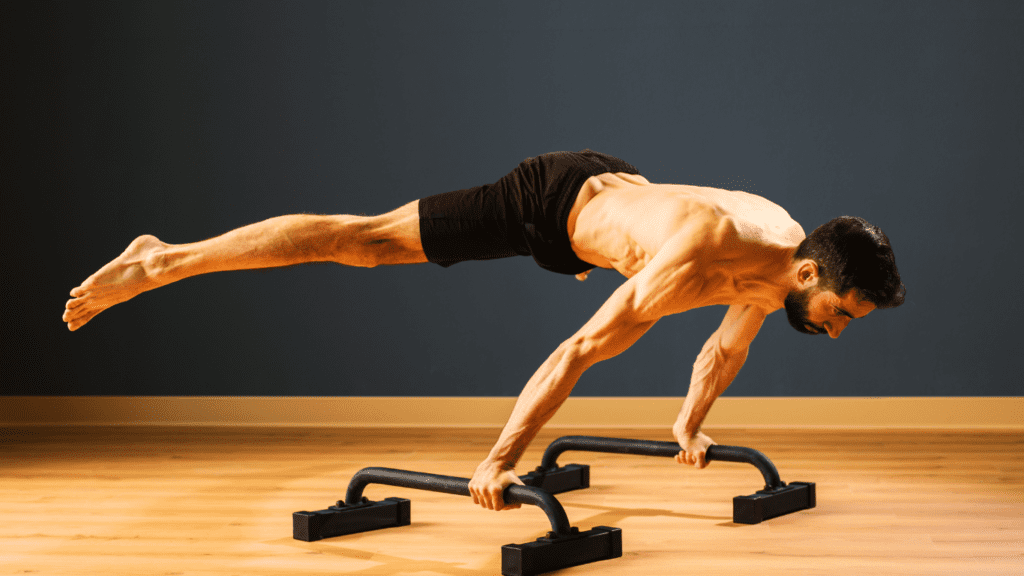
Embrace the Journey of Advanced Calisthenics Workout
Understanding Advanced Calisthenics
The advanced calisthenics workout is more than just a set of challenging exercises; it’s about mastering complex movements that require a high level of strength, skill, and control. From performing a flawless muscle-up to holding a perfect planche, each exercise demands precision and dedication. The essence of advanced calisthenics is pushing the boundaries of what your body can achieve, and each milestone you reach is a testament to your hard work.
Nutritional Support and Recovery
Nutrition and recovery are fundamental to an effective advanced calisthenics workout. Your muscles need proper fuel to recover and grow stronger. A diet rich in protein, carbohydrates, and hydration supports muscle repair and overall performance. Additionally, incorporating recovery techniques such as foam rolling, adequate sleep, and active recovery exercises ensures that your body can handle the demands of advanced training and continue to progress.
Crafting Your Workout Plan
A well-structured workout plan is essential for navigating the complexities of an advanced calisthenics workout. Setting clear goals, planning your weekly schedule, and incorporating progressive overload are key to advancing your skills and strength. Monitoring your progress and making adjustments as needed will help you stay on track and continually challenge yourself. Remember, consistency is crucial—each session builds upon the last, bringing you closer to achieving your fitness goals.
Avoiding Common Mistakes
In any advanced calisthenics workout, avoiding common mistakes is crucial for maintaining progress and preventing injuries. Key errors include poor form, overtraining, and neglecting recovery. By focusing on proper technique and allowing sufficient time for rest and recovery, you protect yourself from setbacks and ensure steady advancement.
Why It Matters
Consistency and Patience
Consistency is the cornerstone of any successful advanced calisthenics workout. Progress may be gradual, but every workout contributes to your overall growth. Stay patient and persistent—remember, even the most accomplished athletes started with foundational training and built up their skills over time. The results will come if you stay dedicated to your routine.
Form and Technique
Proper form and technique are essential in advanced calisthenics. Good form not only maximizes the effectiveness of each exercise but also minimizes the risk of injury. Ensuring you perform each movement correctly will support your progress and help you achieve your goals more efficiently.
Inspirational Facts
- Elite Athletes’ Journey: Many renowned calisthenics athletes, like Al Kavadlo and Frank Medrano, began with basic exercises and progressed to advanced movements through consistent training and dedication. Their success highlights the power of perseverance and gradual progression in achieving exceptional results.
- Scientific Evidence: Studies have demonstrated that progressive resistance training leads to significant improvements in muscle strength and endurance. Research shows that individuals who adhere to a structured, progressive workout plan experience greater gains compared to those who do not follow a systematic approach.
As you continue your journey with advanced calisthenics, remember that every rep, every session, and every milestone is a step towards mastering your physical capabilities. Share your progress with our community, ask questions, and engage with fellow enthusiasts. Your journey is unique, and your experiences can inspire others.
To keep you motivated: Why did the advanced calisthenics athlete go to the beach? To work on their “wave” of progress! Keep making waves and pushing your limits!


